NVIDIA’s GeForce GTX Titan Review, Part 2: Titan's Performance Unveiled
by Ryan Smith & Rahul Garg on February 21, 2013 9:00 AM ESTCrysis: Warhead
Up next is our legacy title for 2013, Crysis: Warhead. The stand-alone expansion to 2007’s Crysis, at over 4 years old Crysis: Warhead can still beat most systems down. Crysis was intended to be future-looking as far as performance and visual quality goes, and it has clearly achieved that. We’ve only finally reached the point where single-GPU cards have come out that can hit 60fps at 1920 with 4xAA.
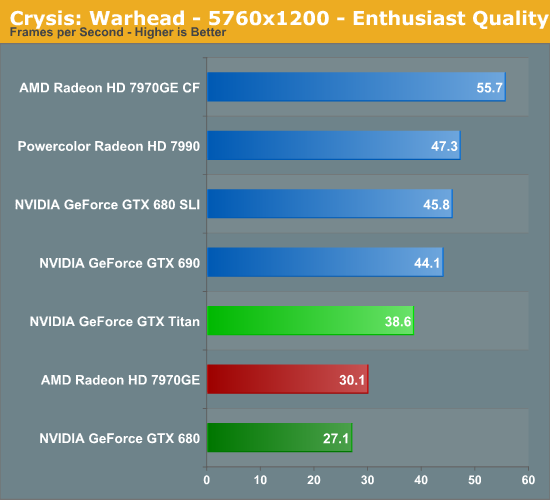

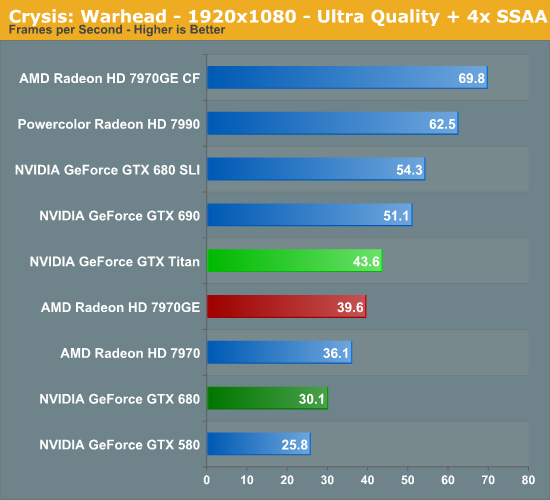

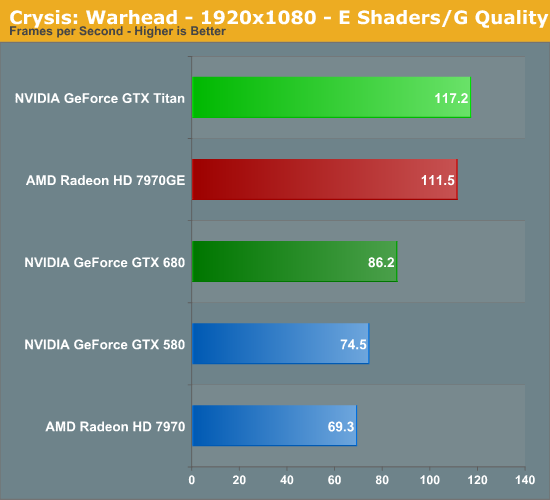
At 2560 we still have a bit of a distance to go before any single-GPU card can crack 60fps. In lieu of that Titan is the winner as expected. Leading the GTX 680 by 54%, this is Titan’s single biggest win over its predecessor, actually exceeding the theoretical performance advantage based on the increase in functional units alone. For some reason GTX 680 never did gain much in the way of performance here versus the GTX 580, and while it’s hard to argue that Titan has reversed that, it has at least corrected some of the problem in order to push more than 50% out.
In the meantime, with GTX 680’s languid performance, this has been a game the latest Radeon cards have regularly cleared. For whatever reason they’re a good match for Crysis, meaning even with all its brawn, Titan can only clear the 7970GE by 21%.
On the other hand, our multi-GPU cards are a mixed bag. Once more Titan loses to both, but the GTX 690 only leads by 15% thanks to GK104’s aforementioned weak Crysis performance. Meanwhile the 7990 takes a larger lead at 33%.
I’d also note that we’ve thrown in a “bonus round” here just to see when Crysis will be playable at 1080p with its highest settings and with 4x SSAA for that picture-perfect experience. As it stands AMD multi-GPU cards can already cross 60fps, but for everything else we’re probably a generation off yet before Crysis is completely and utterly conquered.
Moving on, we once again have minimum framerates for Crysis.
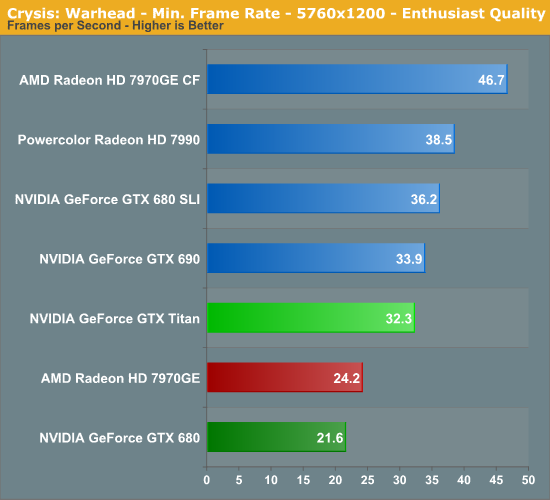
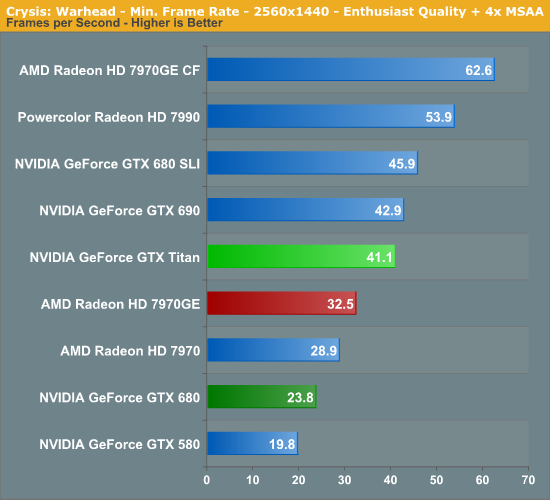
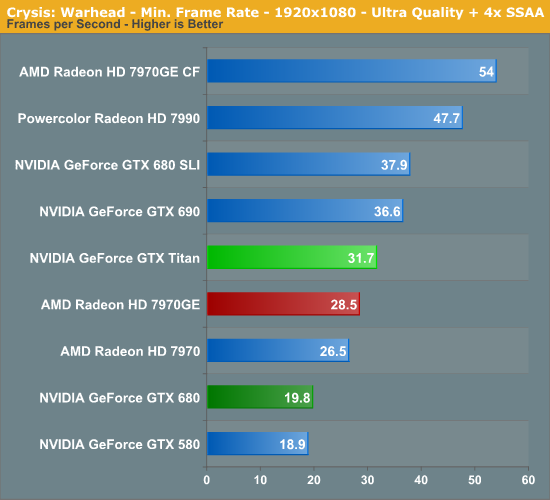
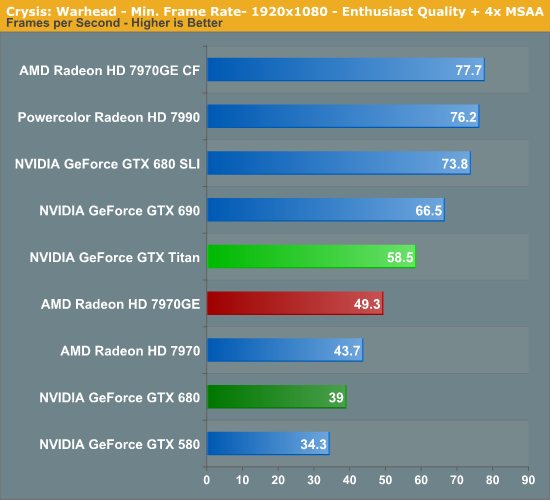
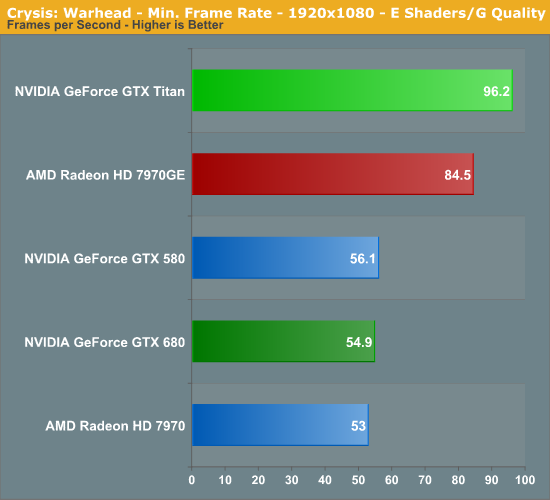
When it comes to Titan, the relative improvement in minimum framerates over GTX 680 is nothing short of obscene. Whatever it was that was holding back GTX 680 is clearly having a hard time slowing down Titan, leading to Titan offering 71% better minimum framerates. There’s clearly much more going on here than just an increase in function units.
Meanwhile, though Titan’s gains here over the 7970GE aren’t quite as high as they were with the GTX 680, the lead over the 7970GE still grows a bit to 26%. As for our mutli-GPU cards, this appears to be a case where SLI is struggling; the GTX 690 is barely faster than Titan here. Though at 31% faster than Titan, the 7990 doesn’t seem to be faltering much.










337 Comments
View All Comments
Veteranv2 - Friday, February 22, 2013 - link
Wow, you base your opinion on 1 game on a point that 1 review site has made without knowing that the FRAPS software measures correctly and that drivers are good with that game?Wow, that blows my mind. How dumb can be people be?
This is the same like saying, wow this 1 musquito didn't give me malaria, malaria doesn't exist....
I am not a fanboy, except for my wallet and honesty.
Anandtech makes a point which it does not prove. That is my point. Hence if you cannot prove a point, but still make it, that makes you subjective. So either prove it, or shut up about it and be objective.
CeriseCogburn - Saturday, February 23, 2013 - link
Yeah it's not one site, this into has been around for years.Just run fraps with your own games vs other frame count methods on both cards idiot.
Oh that's right, you have no experience.
Veteranv2 - Sunday, February 24, 2013 - link
Wow, you are the saddest person I have ever seen on the internet. You seem like you could use a hug or something.Or professional help.
CeriseCogburn - Tuesday, February 26, 2013 - link
Another internet parrot with the usual, repeated a thousand times whenever they have no rebuttal.You fit right in with the rest of the fools.
carlos l - Thursday, February 21, 2013 - link
Titan's most interesting feature is DP performance. The previous gtx 6xx cards have only 1/24 DP, much less than the gtx 5xx. Titan's announced 1/3 DP performance is, in theory, an amazing improvement for gpgpu tasks. It woul be nice if you could ad a benchmark on that feature. I suggest something like GeneferCUDA, an app from Primegrid (a Boinc project) designed for cuda capable cards that uses DP intensively.codedivine - Thursday, February 21, 2013 - link
Look at the DGEMM and FFT (double-precision) benchmarks. Those are both using fp64.chizow - Thursday, February 21, 2013 - link
While the DP performance is great for those that would use it, I think the vast majority of potential buyers would've preferred to see the same neutered DP performance if it meant a more reasonable, historic level of pricing in the $500-$650 range.As a previous owner of these flagship cards, I know I gave 0 fks about the DP performance of the card even though it was respectable relative to the Tesla parts (about half).
alpha754293 - Thursday, February 21, 2013 - link
Does it have the same PCI devID as the Tesla cards?I like how Rahul Garg covered the compute performance using HPC-level code.
Do you or does he know if MATLAB will work with this card?
Thanks.
codedivine - Thursday, February 21, 2013 - link
Rahul here. Not sure about the PCI ID. About MATLAB, while we did not test this, but I see no reason why it will not work with MATLAB.alpha754293 - Thursday, February 21, 2013 - link
Rahul:I loved your analysis. Very useful.
One question question though - nVidia was saying that the single precision peak theorectical floating point rate should be 4.5 TFLOPs. How come your SGEMM only shows 3.something TFLOPS? Is it tuning or optimizations?